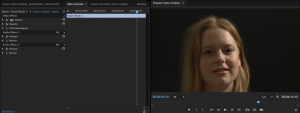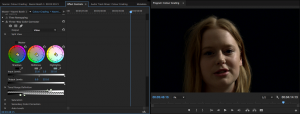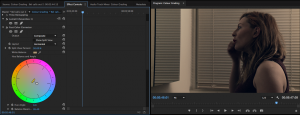
Still taken from BROTHER
My exploration for this semester was centred on creating a series of 10-12 vignettes, videos of approximately 1-minute duration. Within this series I intended to explore both drama and documentary conventions as well as exploring a more experimental and poetic approaches to production. My immediate interest for Film 3 was to look at the distinction between drama and documentary production and to explore ways in production can be mixed or ambivalent to distinction.
Each vignette was treated as a non-chronological aspect of an essay focusing upon Perception. Although non-chronological I hoped that in assembly each vignette would shed light on another providing further clarification or even an alternate viewpoint. My particular area of interest was the disconnection between our identities and the physical forms we present to the world. I treated this topic as a mere starting point and wanted my ideas and avenues of exploration to be shaped by my content creation and musings on production conventions. This decision to explore a somewhat improvised style was a means to challenge my current work ethics and my predisposition for extensive preplanning.
Throughout production I found that I had been somewhat optimistic in what I had intended to achieve. I found that my current habits were difficult to break and I constantly gravitated towards one particular idea. In doing so I believe I neglected avenues of exploration just so I could complete a vignette. I privileged the completion of one particular idea rather than investigating an assortment of other potential ideas. I found that focus also tended to lean towards the vignettes I had envisioned and presented in the Pitch. I also faltered in terms of my research and I believe if I had have delved deeper into other works exploring Perception I may have been able to nurture a more sophisticated approach to my content. Throughout the production period I do believe that I was able to expand my knowledge in referencing to both documentary and dramatic filmmaking. Through the various vignettes I honed my skills working in both an incredibly contrived environment with actors as well as naturalistic settings with non-actors. In these instances I was able to apply a diverse set of solutions for lighting and sound recording, both areas of film I was quite ignorant about.
My final product consists of five completed vignettes that I believe reflected my exploration into drama, documentary and poetic filmmaking. I also believe they are a fair representation of the original essay I have envisioned. In this format though I believe that the interplay between vignettes is negligible and true possibilities of this form only take prominence with a larger collection of vignettes.
Asides from this selection, I also filmed footage that could easily form a number of vignettes if I were to continue my undertaking. I concede that my original idea was more concerned with the completion of my final essay of 10 vignettes rather than the mere act of their creation, exploring the possibilities of film. An alternative approach could have been to base my project around a series of exercises that delved into a variety of production techniques or concerns. Although limited in experimentation, I believe this approach could have yielded unique exercises born of technical constraints or the premise of exploring particular skills.










Recent Comments